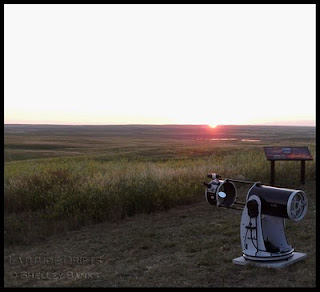 |
| A splash of light that deepens darkness © SB (and yes, I know this is a blue glass, not a clear glass with blue water...) |
Immersed in artificial light, I rarely question it, rarely turn off extra lights, rarely stop to think how new and strange this is in human history.
I'm reading Brilliant: the Evolution of Artificial Light (Jane Brox, 2010), and was struck by a description of lacemakers in European villages working by candlelight, focused and perhaps magnified by glass bottles with blue-tinted water in front of the flame.
My blue wine glass blocks the light. I can`t imagine knitting by that faint glow alone.
 I know so little of darkness.
I know so little of darkness.In July, we visited one of Saskatchewan`s two dark sky preserves, at Grasslands National Park. (The other preserve is in Cypress Hills.)
There, on the night before the late July new moon, we went star watching with parks staff and astronomers from Regina and Saskatoon.
In that deep darkness, even when the sky was still purplish-blue, the Milky Way and constellations were visible, and by late evening, stars clusters and galaxies were shining clear to the naked eye. The experienced naked eye, that is. All I could see was a bright spray of lights from horizon to horizon — until I looked through the first telescope, and double galaxies and nebulas and Saturn's Rings emerged.
I remember that first astronomer saying to look into the spaces between the stars, into the duller absence of light, for the nebulas.
I didn`t understand until, as I was turning away from the telescope, I saw the dark cloud of the Swan Nebula pop out from the sparkling circle of sky. (And yes, it looked like a swan, serenely sailing; depending on the telescope — I was lucky enough to look through several — it looked right-side up, or upside down, and faced left or was inverted.)
Our eyes are drawn by light, that astronomer said. Sometimes, we need to focus instead on what first looks like darkness.
 |
| Telescope waiting for darkness to open the stars. © SB |
~~~~~
Thanks for this, Shelley. Very interesting!
ReplyDeleteI'll have to check out that title...
Thanks, Ariel! (And the other story will be up Sunday.)
ReplyDelete